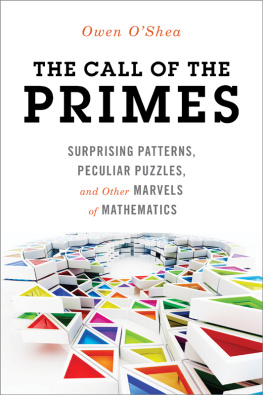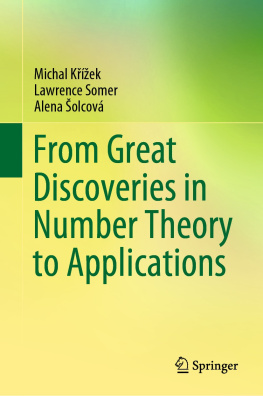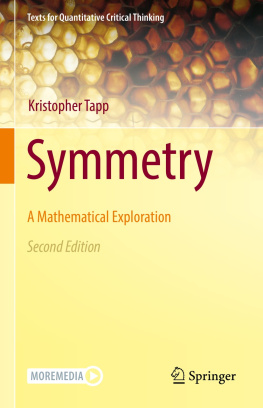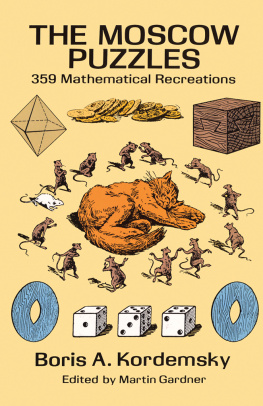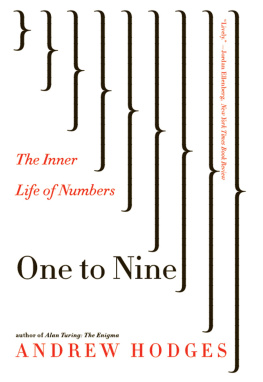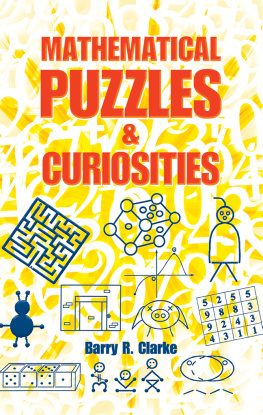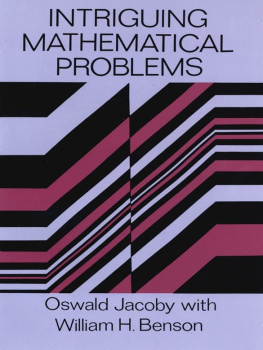
The author, Owen OShea, wishes to thank Steven L. Mitchell, editor-in-chief; Jade Zora Scibilia, senior editor; and all of their colleagues at Prometheus Books, for their expert guidance and skill in editing the contents of this book.

Abbott, H. L., P. Erds, and D. Hanson. On the Number of Times an Integer Occurs as a Binomial Coefficient. American Mathematical Monthly 81 (1974): 25661.
Anderson, Ken. Coincidences: Chance or Fate? London, UK: Blandford, 1995.
Arndt, Jrg, and Christopher Haenel. Unleashed. Berlin, Germany: Springer, 1998.
Asimov, Isaac. Exclamation Point. Chap. 3 in Asimov on Numbers. New York: Bell, 1982.
. A Piece of Pi. Chap. 6 in Asimov on Numbers. New York: Bell, 1982.
Balaguer, Mark. Platonism and Anti-Platonism in Mathematics. New York: Oxford University Press, 2001.
Beiler, Albert H. Digitsand the Magic of 9. Chap. 8 in Recreations in the Theory of Numbers: The Queen of Mathematics Entertains. New York: Dover, 1964.
. On the Square. Chap. 15 in Recreations in the Theory of Numbers: The Queen of Mathematics Entertains. New York: Dover, 1964.
Crompton, Jenny. Unbelievable: The Bizarre World of Coincidences. London, UK: Michael OMara Books, 2013.
Derbyshire, John. Prime Obsession: Bernhard Riemann and the Greatest Unsolved Problem in Mathematics. New York: Plume, 2004.
Deza, Michel Marie, and Elena Deza. Figurate Numbers. 5 Toh Tuck Link, Singapore: World Scientific Publishing, 2012.
Fults, John Lee. Magic Squares. Chicago: Open Court, 1974.
Gardner, Martin. Coincidence. Chap. 1 in Knotted Doughnuts and Other Mathematical Entertainments. New York: W. H. Freeman, 1986.
. Fibonacci and Lucas Numbers. Chap. 13 in Mathematical Circus. New York: Alfred A. Knopf, 1979.
. The Magic Numbers of Dr. Matrix. Buffalo, NY: Prometheus Books, 1985. (See pages 23 and 24 to see how J. F. Kennedy's name is linked to the number 35; chapter 6 contains a nice curiosity concerning .)
. More Mathematical Puzzles of Sam Loyd. New York: Dover, 1960. (Puzzle number 146 in this wonderful book is The Courier Problem; this is a similar problem as that given in chapter 9 concerning the column of soldiers and the dog.)
. Pascal's Triangle. Chap. 15 in Mathematical Carnival. New York: Alfred A Knopf, 1975.
. Some New Discoveries about 3 3 Magic Squares. Chap. 23 in A Gardner's Workout: Training the Mind and Entertaining the Spirit. Natick, MA: A. K. Peters, 2001.
. Phi: The Golden Ratio. Chap. 8 in More Mathematical Puzzles and Diversions. Harmondsworth, Middlesex, England: Penguin Books, 1966. Pages 6981.
. The Pythagorean Theorem. Chap. 16 in Martin Gardner's Sixth Book of Mathematical Diversions from Scientific American. Chicago: University of Chicago Press, 1971.
. The Square Root of 2. Chap. 2 in A Gardner's Workout: Training the Mind and Entertaining the Spirit. Natick, MA: A. K. Peters, 2001.
. Strong Laws of Small Primes. Chap. 12 in The Last Recreations. New York: Springer, 1997.
. 3 3 Magic Squares. Chap. 22 in A Gardner's Workout: Training the Mind and Entertaining the Spirit. Natick, MA: A. K. Peters, 2001.
. The Transcendental Number e. Chap. 3 in Further Mathematical Diversions. Harmondsworth, Middlesex, England: Penguin Books, 1981.
. The Transcendental Number Pi. Chap. 8 in New Mathematical Diversions from Scientific American. Chicago: University of Chicago Press, 1966.
Green, Thomas M., and Charles L Hamberg. Pascal's Triangle. 2nd ed. Charleston, SC: Create Space, 2012.
Hand, David. The Improbability Principle. London, UK. Bantam, 2014.
Henle, Michael, and Brian Hopkins. Sam Loyd's Courier Problem, with Diophantus, Pythagoras and Martin Gardner. Chap 27 in Martin Gardner in the Twenty-First Century. Washington, DC: Mathematical Association of America, 2011. This article originally appeared in College Mathematics Journal 39, no. 5 (November 2008): 38791.
Hersh, Reuben. What Is Mathematics, Really? New York: Vintage Books, 1998.
Hoggatt, Verner E., Jr. Fibonacci and Lucas Numbers. Boston: Houghton Mifflin, 1969.
Holt, Jim. Why Does the World Exist? New York: W. W. Norton, 2012.
Kasner, Edward, and James Newman. Mathematics and the Imagination. New York: Dover, 2003.
Livio, Mario. The Story of Phi: The World's Most Astonishing Number. New York: Broadway Books, 2003.
Loomis, Elisha Scott. The Pythagorean Proposition. Reston, VA: National Council of Teachers of Mathematics, 1968.
Loyd, Sam. Sam Loyd's Cyclopedia of 5,000 Puzzles Tricks and Conundrums with Answers. New York: Franklin Bigelow Corporation, Morningside Press, 1914. Pages 315 and 382.
Maor, Eli. e: The Story of a Number. Princeton: Princeton University Press, 1994.
. The Pythagorean Theorem: A 4,000-Year History. Princeton: Princeton University Press, 2007.
Moscovich, Ivan. The Monty Hall Problem and Other Puzzles. New York: Dover, 2011.
OShea, Owen. Albrecht Drer and His Magic Square. Journal of Recreational Mathematics 35, no. 4 (2006): 28590.
. More Simplebut Little KnownMethods of Calculating Pythagorean Triples. Journal of Recreational Mathematics 37, no. 3 (2008): 18791.
. New Curiosities on the Lo Shu. Journal of Recreational Mathematics 35, no. 1 (2006): 2329.
. Simplebut Little KnownMethods of Calculating Pythagorean Triples. Journal of Recreational Mathematics 37, no. 1 (2008): 18.
Oglivy, C. Stanley, and John T. Anderson. Continued Fractions. Chap. 10 in Excursions in Number Theory. New York: Dover, 1988.
Pasles, Paul C. Benjamin Franklin's Numbers: An Unsung Odyssey. Princeton, NJ: Princeton University Press, 2007.
Pickover, Clifford A. A Passion for Mathematics: Numbers, Puzzles, Madness, Religion, and the Quest for Reality. Hoboken, NJ: John Wiley and Sons, 2005. (Page 78 of this wonderful book contains a beautiful equation involving .)
. Wonders of Numbers: Adventures in Mathematics, Mind and Meaning. New York: Oxford University Press, 2003.
. The Zen of Magic Squares, Circles and Stars. Princeton, NJ: Princeton University Press, 2002.
Plimmer, Martin, and Brian King. Beyond Coincidence: Stories of Amazing Coincidences and the Mystery and Mathematics that Lie behind Them. Cambridge, UK: Icon Books, 2004.
Posamentier, Alfred S. Pi: A Biography of the World's Most Mysterious Number. Amherst, NY: Prometheus Books, 2004.
. The Pythagorean Theorem: The Story of Its Power and Beauty. Amherst, NY: Prometheus Books, 2010.
Posamentier, Alfred S., and Ingmar Lehmann. The Glorious Golden Ratio. Amherst, NY: Prometheus Books, 2011.
Ribenboim, Paulo. The Little Book of Big Primes. New York: Springer, 1991.
Rosenhouse, Jason. The Monty Hall Problem: The Remarkable Story of Math's Most Contentious Brain Teaser. New York. Oxford University Press, 2009.
Sautoy, Marcus du. The Music of the Primes: Searching to Solve the Greatest Mysteries in Mathematics. New York: HarperCollins, 2003.
Shapiro, Stewart. Thinking about Mathematics: The Philosophy of Mathematics. New York: Oxford University Press, 2000.
Sierpinski, Waclaw.
Next page
